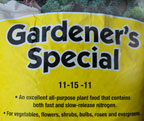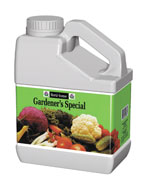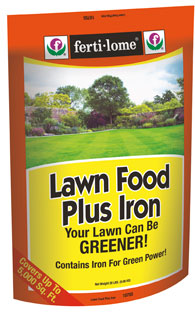 The labels of all commercial fertilizers contain three numbers separated by hyphens, such as 2-1-1 or 14-14-14 or 4-8-3. These are “N-P-K” indicators for Nitrogen, Phosphorus and Potassium, which is represented by the letter K. These are the elements most required in quantity for plant growth and health. The numbers represent the percentage of each element the fertilizer makes available to plants. For example, a fertilizer labeled 5-5-5 contains 5% available* nitrogen, which helps plants create rapid growth, 5% available* phosphorus, which stimulates flowering and fruiting, and 5% available* potassium, which is needed for root and stem growth. (*available means that the element is in a form a plant can readily absorb.)
The labels of all commercial fertilizers contain three numbers separated by hyphens, such as 2-1-1 or 14-14-14 or 4-8-3. These are “N-P-K” indicators for Nitrogen, Phosphorus and Potassium, which is represented by the letter K. These are the elements most required in quantity for plant growth and health. The numbers represent the percentage of each element the fertilizer makes available to plants. For example, a fertilizer labeled 5-5-5 contains 5% available* nitrogen, which helps plants create rapid growth, 5% available* phosphorus, which stimulates flowering and fruiting, and 5% available* potassium, which is needed for root and stem growth. (*available means that the element is in a form a plant can readily absorb.)
Nitrogen: Key To Healthy Plant Growth
The first number is for the amount of Nitrogen, which is the basic building block of plant proteins and a major ingredient of chlorophyll which, through photo synthesis, produces food for plants and makes them green. Too much nitrogen fertilizer can result in weak, leggy plants with few flowers and fruit but lots of lush, tender foliage, which makes them susceptible to pests and diseases. That’s why it is especially important to apply nitrogen fertilizers according to the rates on the package.
 Phosphorus: The Plant Energizer
Phosphorus: The Plant Energizer
Phosphorus, the second number on the label, helps store and transfer the sun’s energy during photosynthesis so it
- stimulates early plant and root growth
- improves a plant’s ability to absorb water and other nutrients
- stimulates blooming and the development of fruits and seeds
- strengthens plants against environmental stresses.
Most annual plants and many vegetables require more phosphorus, particularly in the beginning of their growing season. Older, more established plants need less phosphorus. Several good “bloom fertilizers”are formulated with extra high levels of phosphorus.
Potassium: The Immune System Regulator
The third number is for Potassium (K) which is often called the “regulator,” because it is involved with more than 60 different plant enzymes that control all aspects of plant growth. Potassium:
- helps slow down plant diseases
- helps plants build the cellulose (plant fibers) needed for stalk and stem strength
- aids in photosynthesis
- increases root growth
- increases the size and quality of flowers, fruits, grains, and vegetable
- improves drought resistance by reducing water loss from leaves.
 New Mexico soils are naturally high in potassium so plants grown in the ground here rarely need additional potassium. However, plants grown in containers filled with potting soil need potassium (as well as nitrogen and phosphorus), because it is not naturally present in commercial potting mixes.
New Mexico soils are naturally high in potassium so plants grown in the ground here rarely need additional potassium. However, plants grown in containers filled with potting soil need potassium (as well as nitrogen and phosphorus), because it is not naturally present in commercial potting mixes.
Plants Also Need Micronutrients N-P-K are not the only nutrients plants need for optimum growth and health. Iron, zinc, copper, magnesium, manganese and many others are needed in small, but essential, quantities. They are called trace minerals or micronutrients, and without them plants can develop trace-mineral-deficiency diseases. Check fertilizer labels for the presence of micronutrients (the best brands will contain them).
 A Word About Iron
A Word About Iron
Southwestern soils are typically highly alkaline, with a pH greater than 8.0. For high-alkaline soils we recommend annual applications of sulphur which naturally reduces the pH and releases micronutrients that are present in the soil but are bound up. Low levels of iron are indicated when plants develop chlorosis which shows up in plants as yellowed leaves with green veins. Iron sulphate is the most popular iron supplement because it contains iron in a form plants can readily absorb. But be sure to follow label directions exactly. Too much iron sulphate can burn a plant’s roots.
Come in to either Payne’s Nurseries Garden Centers for expert advice on which fertilizer is right for your plants needs.
